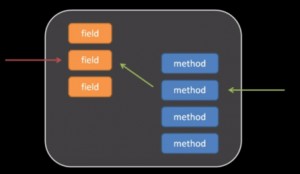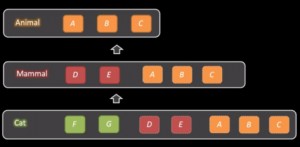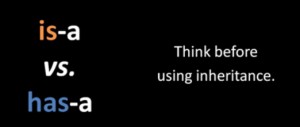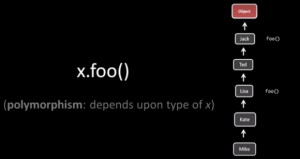--Originally published at chozaoop
Hey there, this post will be about reviewing the concepts which will be featuing in the second partial exam of #TC201, check it out.
Inheritance and Polymorphism were already posted here.
I’ll be taking information from various internet websites and then link the source below.
Delegation
“Delegation is like inheritance done manually through object composition.”
It is a technique where an object expresses certain behavior to the outside but in reality delegates responsibility for implementing that behaviour to an associated object.
Delegation is an abstraction mechanism which centralizes object (method) behaviour.
You can use the delegation pattern when you need to reduce the coupling of methods to their class, you have components that behave identically, but realize that this situation can change in the future.
Or in general: use delegation as alternative to inheritance. Inheritance is a good strategy, when a close relationship exist in between parent and child object, however, inheritance couples objects very closely. Often, delegation is the more flexible way to express a relationship between classes.
Now check this image and this code evolution.
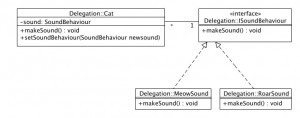
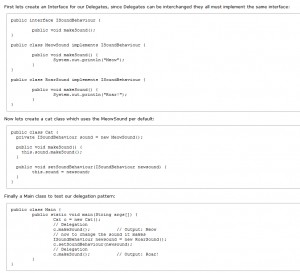
All the information, concepts, images and snips were taken from this SOURCE.
—————————————————————————-
CRC CARDS
I think we should have already watch a video about CRC Cards in this lynda.com course (the bald guy course). Really useful by the way, nevertheless, here’s some other stuff.
CRC stands for CLASS, RESPONSIBILITY and COLABORATION.
Another explanation would be:
The front of a CRC card for a class looks like this,
---------------------------------------------------
| Class Name | Collaborators |
| ----------------------------- | |
| Responsibilities | |
| | |
| | |
| | |
---------------------------------------------------
The "Class Name" section just contains the name of the class.
The "Responsibilities" section describes the tasks an object of the class is
supposed to carry out. It should simply describes what is to be done, and it
should avoid mentioning any of the detaile details of how the tasks are to be
carried out.
The "Collaborators" section should definitely contain any classes the object
needs to carry out its tasks. In some designs, but certainly not all, it may
also include classes that use the object.
The back of a CRC card for a class looks like this,
---------------------------------------------------
| Class Name |
| ----------------------------- |
| Variables |
| |
| |
| Methods |
| |
| |
| |
---------------------------------------------------
The "Variables" section lists the global variables (object state variables)
an object of the class needs to maintain.
The Methods section lists the methods of the class. It should simply list
the method signatures (method return types, names and parameter lists) and brief
descriptions of what the methods do. It should avoid mentioning any details
about how the methods carry out their tasks. Typically, each method carries out
one of the tasks listed in the Responsibilities section.
All of the above was extracted from this SOURCE.
Overloading vs. Overriding
Ken explained this concept on theeeeee Tuesday class i think…
Ok so, we already saw this example from the Intel Forum Website:
1)
Method overloading is used to increase the readability of the program.
Method overriding is used to provide the specific implementation of the method that is already provided by its super class.
2)
Method overloading is performed within class.
Method overriding occurs in two classes that have IS-A (inheritance) relationship.
3)
In case of method overloading, parameter must be different.
In case of method overriding, parameter must be same.
4)
Method overloading is the example of compile time polymorphism.
Method overriding is the example of run time polymorphism.
5)
In java, method overloading can’t be performed by changing return type of the method only. Return type can be same or different in method overloading. But you must have to change the parameter.
Return type must be same or covariant in method overriding.
Java Method Overloading example
- class OverloadingExample{
- static int add(int a,int b){return a+b;}
- static int add(int a,int b,int c){return a+b+c;}
- }
Java Method Overriding example
- class Animal{
- void eat(){System.out.println(“eating…”);}
- }
- class Dog extends Animal{
- void eat(){System.out.println(“eating bread…”);}
- }
Here’s an explanation by Hisham on Stackoverflow:
Method overloading deals with the notion of having two or more methods in the same class with the same name but different arguments.
Method overriding means having two methods with the same arguments, but different implementations. One of them would exist in the parent class, while another will be in the derived, or child class.
Yet another summary by programmerinterview.com:
When overloading, one must change either the type or the number of parameters for a method that belongs to the same class. Overriding means that a method inherited from a parent class will be changed. But, when overriding a method everything remains exactly the same except the method definition – basically what the method does is changed slightly to fit in with the needs of the child class. But, the method name, the number and types of parameters, and the return type will all remain the same.
—————————————————————————-
Wow, kind of a long post, didn’t research THAT much but hey, we got the concepts!
Leave a comment if you’d like to, SHARE and please don’t settle with this post if you still have doubts or any uncomformity.
Sorry if you hate the fact that this was mostly a giant copy-paste, i personally think it’s the most efficient way of gathering information.
See ya!










